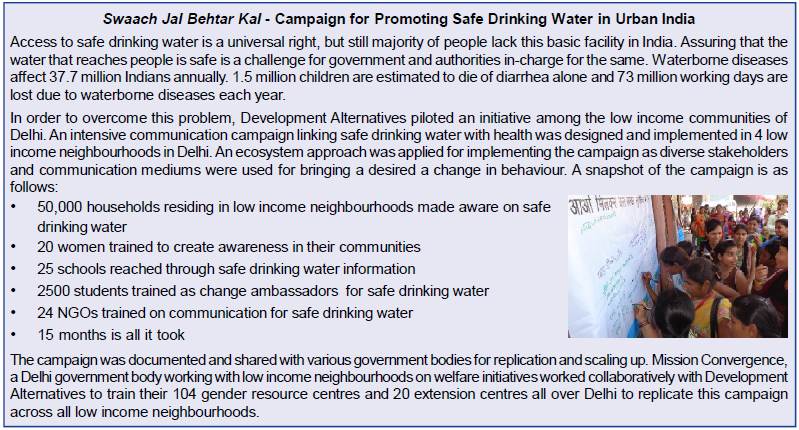|
Influencing Behaviour for
S ustainable development has been defined as ‘Development that meets the needs of the present without compromising the ability of future generations to meet their own needs.’ (Brundtland Commission report, 1987). The idea of sustainable development centers on people’s rights (present and future generations) and people centric approaches of development. This requires innovations, investments, implementation and influence at every stage.Sustainability comes from people’s participation, collaboration, cooperation, accountability and ownership. All these attributes depend on human behaviour. Human behaviour in turn is dependent on knowledge, attitude and practices of human beings as well as social norms, values and culture. The process of influencing behaviour to achieve the aim of sustainable development is defined as ‘Communication for Development’ (C4D) or ‘Strategic Communication’. This involves designing effective and efficient information, knowledge and learning delivery systems. Communication leads to information exchange which helps in establishing consensus among divergent opinions and interests. It also facilitates the building of know-how, decision making and action capacities among the stakeholders. So while designing any development initiative, the process of behaviour change should be an integral part to ensure sustainability of outcome. The process of behaviour change will start from the beginning of the development initiatives and will continue until it becomes a part of the social process. C4D Approaches for Influencing ‘Communication for Development’ (C4D) works on two
kind of approaches. One is ‘communication for result’ and the other is
‘communication about the result’. ‘Communication for result’ is about
designing and implementing communication strategies which influence
behaviour change in a particular direction. Before designing a strategic
C4D approach to support sustainable development processes, there is a
need to understand the target audience’s present knowledge and
practices, identify triggers which can influence behaviour change and
understand how to use those triggers effectively to bring a desired
change in the behaviour and key crucial factors which are necessary to
sustain a particular behaviour. During the process of behaviour change,
it is also important to address social norms and culture which affect an
individual’s behaviour to adopt any change. ‘Communication about the
result’ approach is used by many organisations across the globe to scale
up development initiatives that have proved to be successful using
various communication mediums such as films, community radio, posters,
street plays etc. Development Alternatives’ C4D Strategy Over the last three decades, Development Alternatives (DA) has designed and implemented communication strategies on various development issues to bring out desired changes in the behaviour of target communities. The Development Alternatives Group uses ‘communication for result’ and ‘communication about the result’ approaches together in their development initiatives as the organisation believes that both these approaches are complementary for influencing behaviour change at scale. ‘Communication about the result’ approach can be a tool for scaling up interventions which are tried and tested through the ‘communication for result’ approach. The boxes show how DA has integrated both the ‘communication for result’ and ‘communication about the result’ approaches for maximising scale on promoting safe drinking water among low income communities in urban areas and demystifying and localising climate change information in rural India. Communication for Development plays a role of lifeblood in the sustainable development process. It cannot be seen as a standalone with a short time frame. It has to be an integral part of the development process from the conceptualisation till the end for creating large scale impact on the ground. q
Sutul Srivastava Kavneet Kaur
|

